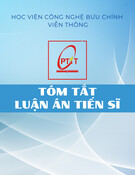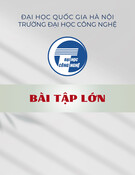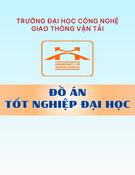TRƯỜNG CĐ KỸ THUẬT CAO THẮNG
KIỂM TRA MÔN CƠ SỞ DỮ LIỆU
( khoa điễn tử- tin học)
(Thời gian 45 phút)
CÂU 1:(3 điểm)
Chuyển mô hình thực thể kết hợp sau sang mô hình dữ liệu
quan hệ. Tìm khóa cho mỗi lược
đồ quan hệ con.
Câu 2:
Cho lược đồ cơ sở dữ liệu với 3 lược đồ quan hệ sau:
Nhanvien(MANV,HOTEN,NGAYSINH,ĐIACHI,
MAPB,MACV)
Mỗi nhân viên có một mã nhân viên (MANV) duy nhất, mỗi MANV
xác định các
thông tin: họ và tên (HOTEN), ngày sinh (NGAYSINH) - NGÀY SINH
là dạng ngày
tháng năm, địa chỉ (ĐIACHI), mã phòng ban(MAPB) và mã chức vụ
(MACV).
Phongban (MAPB,TENPB)
Mỗi phòng ban có một mã phòng ban (MAPB) duy nhất, mỗi
MAPB xác định
tên phòng ban (TENPB).
Chucvu(MACV,TENCV,PHUCAP)
Mỗi chức vụ có một mã chức vụ (MACV) duy nhất, mỗi MACV xác
định tên
chức vụ (TENCV), phu cấp chức vụ(PHUCAP)
Câu 1.Tìm khóa cho mỗi lược đồ quan hệ trên.
Câu 2:Dựa vào lược đồ cơ sở dữ liệu trên, hãy thực hiện các
yêu cầu sau
bằng ngôn ngữ đại số quan hệ
a.Lập danh sách các nhân viên có MAPB là “KT”. Danh sách cần
MANV,
HOTEN,NGAYSINH,ĐIACHI.
b.Lập danh sách các nhân viên có phụ cấp chức vụ. Danh sách cần
các thông
tin: MANV, HOTEN, ĐIACHI, TENPB, TENCV.
CÂU 3:(4 điểm)
Tìm r - s Tính r + s Tính r - s b.(1,0đ) Cho hai lược đồ quan hệ Q1(ABC) và Q2(DEF), r và s là hai quan hệ được cho như sau:
r |><| s
c.(1,0 điểm)
A = D Tìm . Cho hai lược đồ quan hệ Q1(ABC) và Q2(DE), r và s là hai quan hệ được cho như sau:
d.(1,0đ)
Cho quan hệ về khả năng lái các loại máy bay của các phi công:
KHANANG(SỐ HIỆU PHI CÔNG, SỐ HIỆU MÁY BAY)
Hết
TRƯỜNG CĐ KỸ THUẬTCAO THẮNG
ĐỀ KIỂM TRA GIỮA KỲ -MÔN CƠ SỞ DỮ LIỆU (khoa điện tử - tin học) thời gian làm bài 60 phút
CÂU III (5,0đ)
Một phòng giáo dục quận muốn lập một hệ thống thông tin
để quản lý việc làm thi tốt
nghiệp phổ thông cơ sở (lớp 9). Công việc làm thi được tổ
chức như sau:
Lãnh đạo phòng giáo dục thành lập nhiều hội đồng thi (mỗi
hội đồng thi gồm một
trường hoặc một số trường gần nhau). Mỗi hội đồng thi có
một mã số duy nhất (MAHĐT), một
hội đồng thi xác định tên hội đồng thi(TENHĐT), họ tên chủ
tịch hội đồng(TENCT), địa chỉ
(ĐCHĐT),điện thoại(ĐTHĐT).
Mỗi hội đồng thi được bố trí cho một số phòng thi, mỗi
phòng thi có một số hiệu
phòng(SOPT) duy nhất, một phòng thi xác định địa chỉ
phòng thi (ĐCPT). Số hiệu phòng thi
được đánh số khác nhau ở tất cả các hội đồng thi.
Giáo viên của các trường trực thuộc phòng được điều động
đến các hội đồng để coi thi,
mỗi trường có thể có hoặc không có thí sinh dự thi, mỗi
trường có một mã trường duy nhất
(MATR), mỗi mã trường xác định tên trường(TENTR),địa chỉ
(ĐCTR), loại hình đào tạo (LHĐT)
(Công lập, chuyên, bán công, dân lập,…). Các giáo viên của
một trường có thể làm việc tại
nhiều hội đồng thi. Một giáo viên có một mã giáo
viên(MAGV), một mã giáo viên xác định tên
giáo viên (TENGV), chuyên môn giảng dạy (CHUYENMON),
chức danh trong hội đồng
thi(CHUCDANH).
Các thí sinh dự thi có một số báo danh duy nhất(SOBD), mỗi
số báo danh xác định tên
thí sinh(TENTS), ngày sinh (NGSINH), giới tính (PHAI), mỗi
thí sinh được xếp thi tại một phòng
thi nhất định cho tất cả các môn, mỗi thí sinh có thể có
chứng chỉ nghề (CCNGHE) hoặc không
(thuộc tính CCNGHE kiểu chuổi, CCNGHE=”x” nếu thí sinh
có chứng chỉ nghề và CCNGHE
bằng rổng nếu thí sinh không có chứng chỉ nghề).Thí sinh
của cùng một trường chỉ dự thi tại
một hội đồng thi.
Mỗi môn thi có một mã môn thi duy nhất (MAMT), mỗi mã
môn thi xác định tên môn
thi(TENMT), buổi thi (BUOI), ngày thi (NGAY). Giả sử toàn
bộ các thí sinh trong hội đồng thi đó
đều thi chung một số môn do sở giáo dục quy định (có thể
thay đổi tuỳ theo năm). Mỗi môn thi
được tổ chức trong một buổi của một ngày nào đó. Ứng với
mỗi môn thi một thí sinh có một
điểm thi duy nhất(ĐIEMTHI)
Dựa vào phân tích ở trên, giả sử ta có lược đồ cơ sở dữ liệu
sau:
HĐ(MAHĐT,TENHĐT, TENCT, ĐCHĐT,ĐTHĐT)
PT(SOPT,ĐCPT,MAHĐT)
TS(SOBD, TENTS,NGSINH,PHAI,CCNGHE, MATR,SOPT)
MT(MAMT,TENMT,BUOI,NGAY)
GV(MAGV,TENGV,CHUYENMON,CHUCDANH,MAHĐT,MA
TR)
TR(MATR,TENTR,ĐCTR,LHĐT)
KQ(SOBD,MAMT,ĐIEMTHI)
YÊU CẦU
1.Hãy xác định khóa cho mỗi lược đồ quan hệ trên.
2.Dựa vào lược đồ cơ sở dữ liệu trên, hãy thực hiện các yêu
cầu sau bằng
SQL.
a. Danh sách các thí sinh thi tại phòng thi có số hiệu phòng
thi (SOPT) là “100”
Yêu cầu các thông tin: SOBD,TENTS,NGSINH,TENTR
b. Kết quả của môn thi có mã môn thi (MAMT) là “T” của tất
cả các thí sinh có mã
trường (MATR) là “NTMK”, kết quả được sắp theo chiều
giảm dần của điểm thi
(ĐIEMTHI).
Yêu cầu các thông tin:SOBD,TENTS, ĐIEMTHI
c. Tổng số thí sinh có chứng chỉ nghề(CCNGHE) của mỗi
trường, thông tin cần được
sắp theo chiều tăng dần của TENTR.
Yêu cầu các thông tin: MATR, TENTR, SOLUONGCC, trong
đó
SOLUONGCC là thuộc tính tự đặt.
Hết
(Sinh viên không được sử dụng tài liệu
Cán bộ coi thi không giải thích)
1. Consider a relation Q(A,B,C,D) with the following functional
dependencies:
A → B and B → C
The number of superkeys of Q is:
(a) 2
(b) 3
(c) 4
(d) 5
(e) None of the above
2. Which of the following functional dependencies must be FALSE
?
a) X → Y ⇒ XZ → YZ
b) X → Y; YW → Z ⇒ XW→ Z.
c) X → Y, X → Z ⇒ X → YZ
d) X → Y; Z ⊆ Y ⇒ X → Z
e) None of the above
3. Consider relation S(B, G, U, N, A) with the FD's: BG → U, G →
N, NA→ B
What are all the keys of S ?
a) {B, G} and {N, A}
b) {U, A}
c) {G, A}
d) {B,N}
e) {B, G, U, N}
f) {B, G, A} and {G, N, A}
4. Which one of the following is correct?
(a) All FDs must involve the attributes of the same relation.
(b) All FDs must involve only a single attribute on the left side.
(c) All FDs must involve only a single attribute on the right side.
(d) All FDs must involve only single attributes on both sides.
(e) None of the above
Giáo Trình Cơ Sở Dữ Liệu Trang 95
Biên soạn : Phan Tấn Quốc- Trường Cao Đẳng Kỹ Thuật Cao Thắng
5. Assume the relation R(A, B, C ,D, E) is in at least 3NF. Which of
the following functional
dependencies must be FALSE?
a. A, B → C
b. A, B → D
c. C, D → E
d. None of the above
6. SQL provides a number of special aggregate functions. Which
one of the following is not
included in SQL?
(a) SUM
(b) MAX
(c) MIN
(d) COUNT
(e) MEDIAN
7. Which of the following finds all groups meeting stated
conditions?
(a) Select
(b) Where
(c) Find
(d) Having
8. The ___________ clause is used to restrict the groups returned
by a query.
(a) FROM
(b) WHERE
(c) HAVING
(d) GROUP BY
9. To get all the customers from Hawaii sorted together, which of
the following would be used?
(a) Order By
(b) Group By
(c) Having
(d) Sort
Giáo Trình Cơ Sở Dữ Liệu Trang 96
Biên soạn : Phan Tấn Quốc- Trường Cao Đẳng Kỹ Thuật Cao Thắng
10. The ____ set operator will show all rows common to both
tables A and B.
(a) intersection
(b) union
(c) difference
(d) product
11. Using the product operator, if table A has 2 rows and table B
has 4 rows, the number of
rows in the product of these two tables is:
(a) 4.
(b) 8.
(c) 16.
(d) 20.
12. Suppose relation R(A,B,C,D,E) has the following functional
dependencies:
A → B
B → C
BC → A
A → D
D → E
Which of the following is not a key?
(a) A
(b) E
(c) B
(d) D
(e) (b) and (d)
13. Consider a relation Q with five attributes L V O B Y. You are
given the follwoing
dependencies: L → V; VO → Y and YB → L.
The number of superkeys of Q is: (not superkeys)
(a).2
(b).3
(c),4
(d).5
Giáo Trình Cơ Sở Dữ Liệu Trang 97
Biên soạn : Phan Tấn Quốc- Trường Cao Đẳng Kỹ Thuật Cao Thắng
14. Use the following tables and data,All of the fields are
Integers.The table names are Q
A B C D
1 2 3 4
1 3 5 7
2 3 4 5
2 4 6 8
5 6 7 8
How many records does the following SQL example return?
SELECT * FROM Q WHERE A>=5 OR D>=7;
a) 1
b) 2
c) 3
d) 4
15. How many records does the following SQL example return?
SELECT sum(A) AS S FROM Q GROUP BY A;
16. The SQL below will return one value. What is it?
17. How many records does the following SQL example return?
SELECT count(*) FROM Q GROUP BY A, B;
a) 2
b) 3
c) 4
d) 6
e) None of the above
18. Use the following tables and data..All of the fields are
Integers.The table names are R and
How many records does the following SQL example return?
SELECT COUNT(*) FROM R, S WHERE R.A=S.D OR R.B=S.E;
a) 1
b) 2
c) 3
d) 4
19. How many records does the following SQL example return?
SELECT COUNT(*) FROM R, S WHERE R.A=S.D;
a) 0
b) 1
c) 2
d) 4
20. Which of the following statements contains an error?
(a) SELECT * FROM emp WHERE empid = 493945;
(b) SELECT empid FROM emp WHERE empid= 493945;
(c) SELECT empid FROM emp;
(d) SELECT empid WHERE empid = 56949 AND lastname = 'SMITH';
21. Which of the following statements will return the names of
the products with Product ID 10,
11, or 42?
(a) SELECT ProductName FROM products WHERE ProductID IN
(10,11,42)
(b) SELECT ProductName FROM products WHERE ProductID IN 10
OR 11 OR 42
(c) SELECT ProductName FROM products WHERE ProductID =
(10,11,42)
(d) SELECT ProductName FROM products WHERE ProductID IS
(10,11,42)
(e) None of the above
22. Which of the following commands will return the list of
product names sorted in ascending
alphabetic order?
(a) SELECT ProductName FROM products ORDER BY ProductName
DESC
(b) SELECT ProductName FROM products ORDER BY ProductName
ASC
(c) SELECT ProductName FROM products SORTED BY
ProductName ASC
(d) SELECT ProductName FROM products SORTED BY
ProductName DESC
(e) None of the above
23. Which of the following will return a list of every product ID
currently listed in the
order_details table where each product ID is listed only once?
(a) SELECT DISTINCT ProductID FROM order_details
(b) SELECT ProductID FROM order_details ONLY ONCE
(c) SELECT ProductID FROM order_details
(d) SELECT UNIQUE ProductID FROM order_details
(e) None of the above
24. In the instance of the relation R(A,O,T,V,U) shown below,
which of the following functional
dependencies hold ?
25. Which of the following statements contains an error?
(a) SELECT cid, sum (qty) from orders group by cid having
sum(dollars) > 2000;
(b) SELECT aid, avg (qty) from orders group by aid;
(c) SELECT cid, sum (dollars) from orders;
(d) SELECT count (*) from orders;
26. Which code lists employees by descending order of salary
(a) SELECT * FROM EMPLOYEES SORT BY SALARY DESCENDING;
(b) SELECT * FROM EMPLOYEES IN ORDER OF SALARY;
(c) SELECT * FROM EMPLOYEES ORDER BY SALARY DESC;
(d) SELECT * FROM EMPLOYEES ORDER BY SALARY;
27. In order to perform a join, which criteria must be true?
(a) The two tables must have only one column exact same
columns.
(b) The tables in the join need to have common rows.
(c) The two tables must both have primary keys
(d) The two tables must have a common column.
28. Consider the follow attributes and functional dependencies:
A B C
AB→ C
C → A
List all keys (not superkeys):
29. What will result from the following SQL Select statement?
Giáo Trình Cơ Sở Dữ Liệu Trang 101
Biên soạn : Phan Tấn Quốc- Trường Cao Đẳng Kỹ Thuật Cao Thắng
Select min(product_description)
from product_v;
(a) The minimum value of product_description will be displayed.
(b) An error message will be generated.
(c) The first product description alphabetically in product_v will be
shown.
(d) none of the above
30. The following two SQL statements will produce the same
results:
Select last_name, first_name
from customer
where credit_limit > 99 and credit_limit < 10001;
Select last_name, first_name
from customer
where credit_limit between 100 and 10000;
a.TRUE
b.FALSE
31. The following query will execute without errors:
select customer.customer_name, salesman.sales_quota
from customer
where customer.salesman_id =
(select salesman_id
from salesman
where lname = ‘SMITH’);
a.TRUE
b.FALSE
32. Table TT {J , D , C , V , N , G } and a set of functional
dependencies
J,C,N → V,G
D → C,V,G
J → D,C,G
The closure of {D } is:
Giáo Trình Cơ Sở Dữ Liệu Trang 102
Biên soạn : Phan Tấn Quốc- Trường Cao Đẳng Kỹ Thuật Cao Thắng
a) J D C V N G
b) J D C V G
c) J C V G
d) D C V N
e) D C V G
33. Table TT {O , M , Z , I , Q } and a set of functional dependencies
O → I,Q
I → M,Z
O,Z → M
Table TT is:
a) 1 NF
b) 2 NF
c) 3 NF
34. For which task in SQL would you use an IN clause
(a) To query the database for unknown values
(b) To query the database for a range of values
(c) To query the database for a character pattern
(d) To query the database for values in a specified list
35. A Cartesian product is
(a) A group function
(b) Produced as a result of a join select statement with no where
clause
(c) The result of fuzzy logic
(d) A special feature of Oracle Server
36. A type of query that is placed within a WHERE or HAVING
clause of another query is called
a:
(a) master query.
(b) subquery.
(c) superquery.
(d) multi-query.
37. In order to perform a join, which criteria must be true?
Giáo Trình Cơ Sở Dữ Liệu Trang 103
Biên soạn : Phan Tấn Quốc- Trường Cao Đẳng Kỹ Thuật Cao Thắng
(a) The two tables must have the exact same columns.
(b) The tables in the join need to have common rows.
(c) The two tables must both have primary keys
(d) The two tables must have at least one common column.
38. An attribute(s) which uniquely determines a tuple within a
relation is called a:
(a) Candidate key
(b) Foreign key
(c) Primary key
(d) All of the above
(e) A and C
39. Table Q(A,B,C) and a set of functional dependencies
AB → C;
C → A;
Table Q is:
a) 1 NF
b) 2 NF
c) 3 NF
d) BCNF
40. Table Q(A,B,C,D) and a set of functional dependencies
AB → C;
D → B;
C → AD
Table Q is:
a) 1 NF
e) 2 NF
f) 3 NF
g) BCNF
41. The following table and functional dependencies exhibits what
type of dependency?
Table(A, B, C)
A -> C
A -> B
B -> C
(a) Partial Dependence
(b) Transitive Dependence
(c) Full Dependence
(d) A and B
(e) None of the above
43. Table Q{A , B , C , D} and a set of functional dependencies
A → B, C
D → C
The closure of {A D } is:
a) A D
b) A D B C
c) B C
d) None of the above
44. Consider the relation student(sno, sname, cname, cno) where
(sno, cno) or (sname,
cname) are candidate keys. There are functional dependencies
within the keys.
Giáo Trình Cơ Sở Dữ Liệu Trang 105
Biên soạn : Phan Tấn Quốc- Trường Cao Đẳng Kỹ Thuật Cao Thắng
The highest normal form whose requirements this relation
satisfies is:
(a) 1NF
(b) 2NF
(c) 3NF
(d) BCNF
45. Let R be a relation with attributes (B,I,N,R,U,L) and let the
following functional
dependencies hold.
B → I
B → N
N R → U
N R → L
I → U
Given the above functional dependencies, which of the following
functional dependencies does
not hold:
a) N R → U L
b) B R → L
c) B → U
d) I→ N R
46. Suppose relation R(S,G,F,Y,N) has the following functional
dependencies:
S → G
G → F
G F → S
S → Y
N → S
Y → N
Which of the following is not a key?
a) N b) G,F
c) S d) Y
47. Table TT {A , N , H , K , J , O , X } and a set of functional
dependencies
A, N → O, X
Giáo Trình Cơ Sở Dữ Liệu Trang 106
Biên soạn : Phan Tấn Quốc- Trường Cao Đẳng Kỹ Thuật Cao Thắng
J → A , N, H
H, O → K, X
H, K, X → O
A, N, X → J
The closure of {A N } is:
e) A H K X J O
f) A N H K X J
g) A N H X J O
h) A N H K X J O
48. Consider the follow attributes and functional dependencies:
A B C D E F H
A→ D
AE → H
DF → BC
E → C
H → E
List all keys (not superkeys):
49. (Đề 48) Consider the decomposition into 3 relations: (AD) (EC)
(ABEFH). Is this
decomposition in
(a) BCNF
(b) 3NF
(c) 1NF
(d) None of the above

































